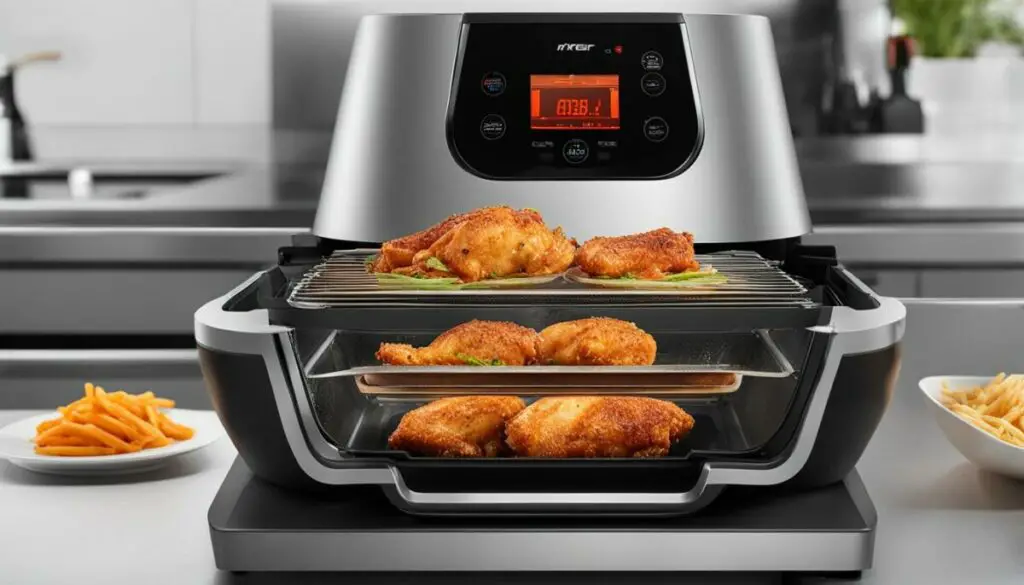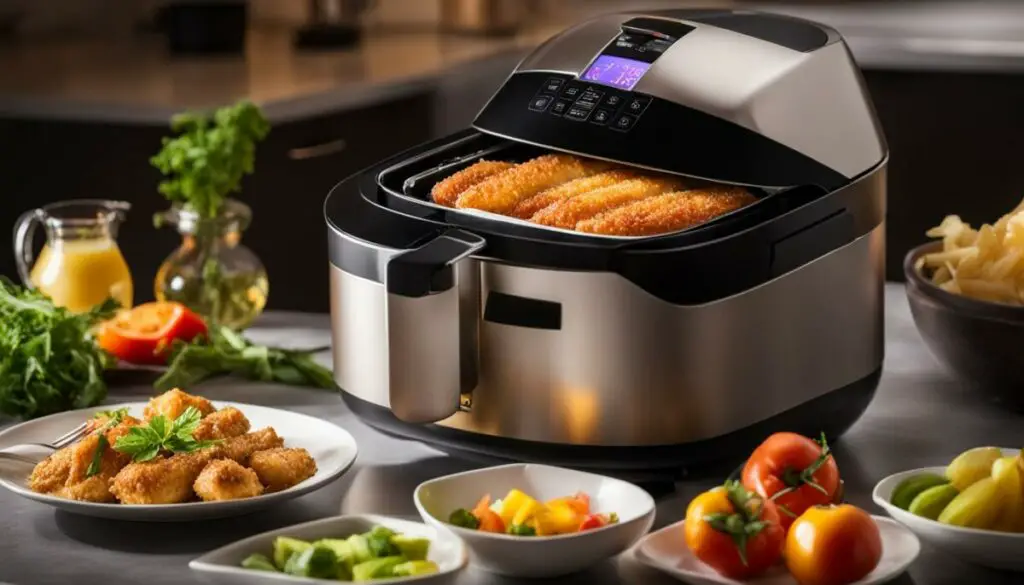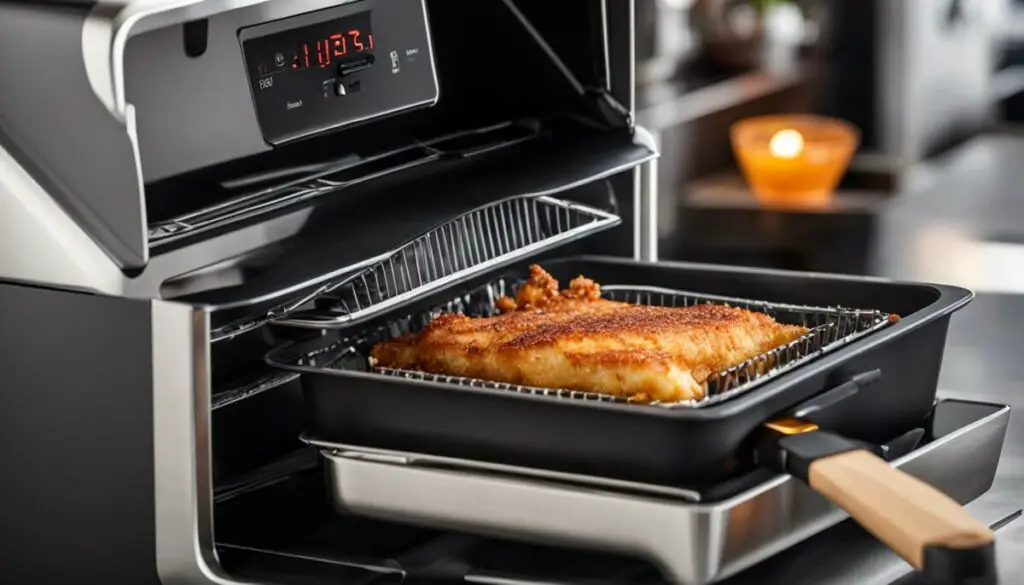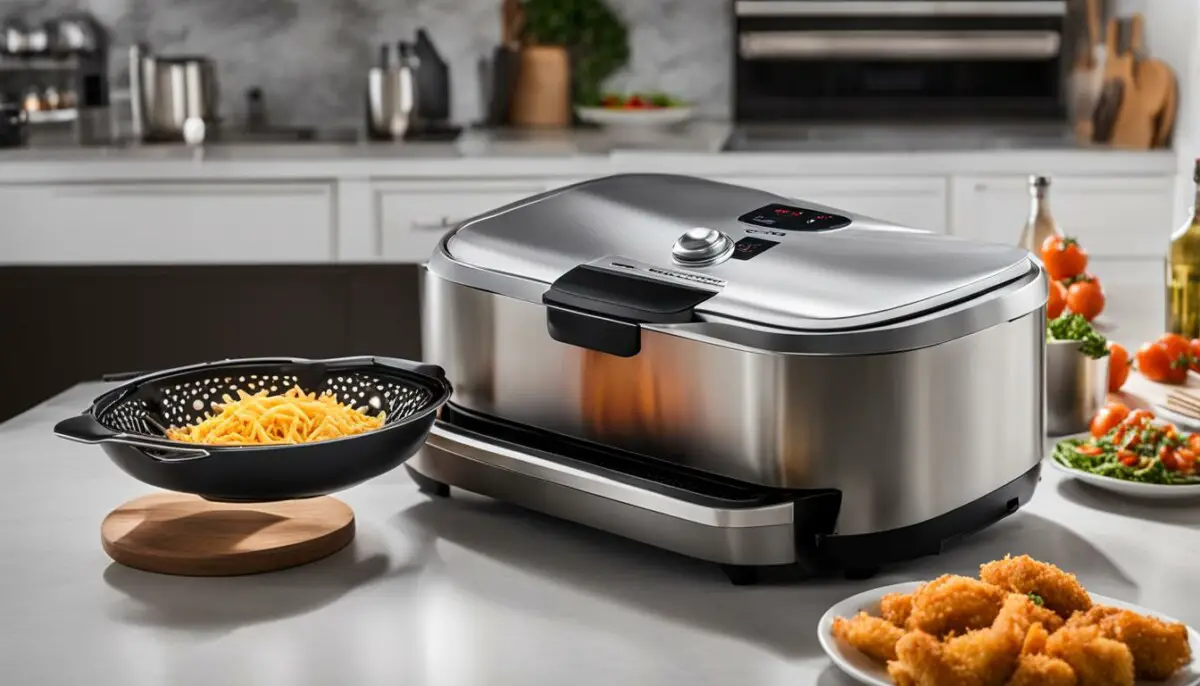Last Updated on 5 months by Francis
Welcome to our complete guide on infrared fryers! Infrared fryers have gained popularity as a kitchen appliance that promises the same results as deep-frying but with less oil and more health benefits. In this article, we’ll explore whether these fryers are truly healthy, how they work, their advantages and disadvantages, and even alternative cooking methods. So, whether you’re a health-conscious foodie or simply curious about the latest kitchen gadgets, read on to discover everything you need to know about infrared fryers!
Contents
Key Takeaways:
- Infrared fryers aim to mimic the results of deep-frying with less oil and healthier cooking methods.
- They use rapid air technology to circulate hot air around the food, resulting in a crispy texture.
- Using infrared fryers can have health benefits, such as reducing the consumption of unhealthy fats and retaining more nutrients.
- While infrared fryers are generally considered healthier than traditional fryers, it’s important to consider overall dietary habits and portion sizes.
- There are alternatives to infrared fryers, such as air fryers, convection ovens, and traditional cooking methods.
How Do Infrared Fryers Work?

Infrared fryers are innovative kitchen appliances that utilize rapid air technology to cook food without excessive oil. By understanding how infrared fryers work, you can make informed decisions about incorporating this cooking method into your culinary routine.
The heating mechanism in an infrared fryer is located in the top section of the appliance. It uses infrared radiation to generate heat, which is then circulated by a fan. As the hot air circulates around the food, it creates a crispy texture similar to deep-frying, but with significantly less oil.
Unlike traditional fryers that rely on oil to transfer heat to the food, infrared fryers cook with dry heat. This means you can achieve crispy and evenly cooked results without the greasiness associated with deep-fried foods. Additionally, the rapid air technology in infrared fryers reduces cooking time, making them a convenient option for busy individuals.
How Infrared Fryers Work: Step-by-Step Guide
- Preheat the infrared fryer to the desired temperature.
- Place the food in the fryer basket, ensuring that it’s evenly spread out for optimal cooking.
- Set the timer and let the infrared fryer do its magic. The rapid air circulation will cook the food efficiently and evenly.
- Once the cooking time is up, carefully remove the food from the fryer, using kitchen utensils to avoid burns.
- Enjoy your crispy and delicious meal!
With their ability to produce crispy results without excessive oil, it’s no wonder that infrared fryers have become a popular cooking appliance. Whether you’re looking to indulge in guilt-free fried foods or simply want to speed up your cooking process, infrared fryers offer a convenient and healthy solution.
Table: Comparing Infrared Fryers with Traditional Fryers
| Category | Infrared Fryers | Traditional Fryers |
|---|---|---|
| Oil Usage | Requires little to no oil | Requires a significant amount of oil |
| Cooking Time | Cooks food faster due to rapid air circulation | Takes longer to cook due to slower heat transfer |
| Crispiness | Produces crispy results with minimal greasiness | Can result in greasier and less crispy food |
| Health Impact | Reduces unhealthy fats and calories | May increase intake of unhealthy fats and calories |
| Convenience | Offers quick and hassle-free cooking | Requires more monitoring and potential mess |
Health Benefits of Using Infrared Fryers

Using infrared fryers can offer numerous health benefits compared to traditional frying methods. One of the main advantages is the reduced need for oil. Infrared fryers require little to no oil, which means you can enjoy crispy and delicious fried food without the excess fat and calories. This is especially beneficial for individuals looking to lower their intake of unhealthy fats and maintain a healthier diet.
Beyond the reduced oil consumption, cooking with infrared fryers also helps to retain more nutrients in the food. The rapid air technology used in these fryers cooks the food quickly and evenly, helping to preserve vitamins and minerals that may be lost in other cooking methods. As a result, you can enjoy meals that are not only tasty but also packed with essential nutrients, making infrared fryers a great option for health-conscious individuals.
Infrared fryers are also an excellent choice for individuals with dietary restrictions or special health needs. The ability to cook with little or no oil makes it easier to accommodate specific dietary requirements, such as low-fat or low-cholesterol diets. Additionally, infrared fryers can be used to prepare a variety of dishes, from fried chicken to roasted vegetables, providing versatility and healthier alternatives to traditional frying.
Beyond the health benefits:
“Infrared fryers offer a convenient way to enjoy your favorite fried foods without sacrificing your health. With their ability to reduce oil consumption, retain nutrients, and cater to dietary needs, infrared fryers are a valuable addition to any kitchen.”
Overall, infrared fryers offer a healthier cooking option by reducing oil intake, retaining nutrients, and providing versatility for individuals with specific dietary needs. Incorporating an infrared fryer into your cooking routine can help you enjoy guilt-free fried foods while maintaining a balanced and nutritious diet.
Are Infrared Fryers Better for Your Health Compared to Traditional Fryers?
Infrared fryers are often hailed as a healthier alternative to traditional fryers due to their use of hot air instead of oil. This cooking method reduces the consumption of unhealthy fats and lowers the calorie content of the food, making it a more attractive option for health-conscious individuals. However, it’s important to consider that overall dietary habits and portion sizes also play a significant role in determining the healthiness of a cooking method.
While the use of infrared fryers has clear advantages in terms of reducing fat and calories, it is essential to note that the healthiness of a meal is not solely determined by the cooking method. The ingredients used, cooking techniques, and overall balanced diet are equally important factors to consider. A meal prepared using an infrared fryer may still contain unhealthy ingredients or be served in excessive portions, compromising its overall health benefits.
Furthermore, it’s worth considering that traditional fryers also offer unique advantages. Traditional frying methods can impart a distinct flavor and texture to food that may not be fully replicated by infrared fryers. The use of oil in traditional fryers can also enhance the Maillard reaction, contributing to the development of desirable flavors and browning. These factors may be important considerations for individuals who prioritize taste and culinary preferences over solely focusing on health benefits.
In conclusion, while infrared fryers can be considered a healthier option compared to traditional fryers due to their reduced fat and calorie content, it’s important to approach cooking holistically. A balanced diet, appropriate portion sizes, and mindful ingredient choices are crucial for maintaining overall health and well-being, regardless of the cooking method chosen.
Infrared Fryer Health Risks
While using infrared fryers can provide health benefits, it’s important to be aware of potential risks associated with their use. Overcooking or burning food in an infrared fryer can produce potentially harmful compounds that may have adverse effects on your health. To minimize these risks, it’s crucial to follow proper cooking guidelines and avoid excessive heat or cooking times.
One particular concern with infrared fryers is the formation of acrylamide, a chemical compound that can form when starchy foods are cooked at high temperatures. Acrylamide has been linked to an increased risk of cancer in animal studies, although the evidence in humans is still inconclusive. To reduce the formation of acrylamide, it’s recommended to avoid overcooking or burning food, as well as to follow specific cooking instructions provided by the manufacturer.
Furthermore, it’s important to keep in mind that infrared fryers do not eliminate all health risks associated with deep-frying. While they require less oil compared to traditional fryers, they can still produce food that is high in calories and unhealthy fats if used improperly or combined with unhealthy ingredients. As with any cooking method, portion control, balanced nutrition, and overall dietary habits play a crucial role in determining the healthiness of your meals.
Comparison: Infrared Fryer vs. Traditional Fryer Health Risks
| Infrared Fryer | Traditional Fryer | |
|---|---|---|
| Health Risks | Potential formation of acrylamide when food is overcooked or burned. | Potential formation of acrylamide when food is overcooked or burned. |
| Oil Consumption | Requires less oil compared to traditional fryers. | Typically uses more oil for deep-frying. |
| Calorie Content | Can still produce high-calorie food depending on ingredients and cooking technique. | Can produce high-calorie food due to the absorption of oil. |
Overall, while infrared fryers offer a healthier alternative to traditional fryers by reducing oil consumption, it’s important to be mindful of potential health risks and use them responsibly. By following proper cooking techniques and maintaining a balanced diet, you can enjoy the benefits of crispy, delicious food while minimizing any potential negative effects.
Cooking with Infrared Fryers vs. Traditional Methods

When it comes to cooking, using an infrared fryer can offer several advantages compared to traditional methods. Infrared fryers use rapid air technology to circulate hot air around the food, resulting in a crispy texture without the need for excess oil. This not only reduces the consumption of unhealthy fats but also lowers the calorie content of the food.
One of the key benefits of cooking with an infrared fryer is the reduced cooking time. Infrared fryers cook food faster compared to traditional methods such as deep-frying or oven baking. This can be a time-saving solution for those who are always on the go or looking to prepare meals quickly.
Additionally, infrared fryers typically retain more nutrients in the food compared to deep-frying or other high-heat methods. The cooking process preserves the natural flavors and textures of the ingredients while minimizing the loss of essential nutrients. This makes infrared fryers a healthier option for those who prioritize nutrient-rich meals.
Comparison of Cooking Methods
| Infrared Fryers | Traditional Methods | |
|---|---|---|
| Oil Consumption | Little to no oil required | Higher amount of oil needed |
| Cooking Time | Faster cooking time | Varies depending on the method |
| Nutrient Retention | Retains more nutrients | May result in nutrient loss |
| Taste and Texture | Crispy texture without excess oil | Varies depending on the method |
While infrared fryers offer many benefits, it’s important to note that personal preference and cooking techniques may influence the choice between infrared fryers and traditional methods. Some individuals may still prefer the taste and texture achieved through deep-frying or oven baking. Ultimately, it’s essential to select a cooking method that suits your cooking preferences and dietary goals.
Whether you choose to cook with an infrared fryer or stick to traditional methods, both options can provide delicious and satisfying meals. Experimenting with different cooking techniques can help you discover new flavors and textures while maintaining a healthy balance in your diet. Keep in mind that moderation and portion control are key to enjoying any type of cooking method.
Advantages of Using Infrared Fryers

Infrared fryers offer several advantages that make them a popular choice for cooking enthusiasts. Here are some of the key benefits:
1. Faster Cooking Time
One of the notable advantages of using infrared fryers is their ability to cook food faster compared to traditional methods. The rapid air technology used in these fryers ensures even heat distribution, resulting in reduced cooking times. This can be particularly beneficial for busy individuals or those who want to prepare meals quickly without compromising on taste or texture.
2. Little to No Oil Required
Unlike deep-frying, which requires a significant amount of oil, infrared fryers can achieve crispy and delicious results with little to no oil. This means you can enjoy your favorite fried foods with fewer calories and less unhealthy fats. By reducing oil consumption, infrared fryers provide a healthier alternative for those concerned about their dietary intake.
3. Crispy Texture and Great Taste
Infrared fryers are designed to produce crispy and evenly cooked food. The hot air circulation creates a golden-brown exterior while preserving the moisture inside, resulting in a satisfying texture that closely resembles deep-fried food. The taste is also enhanced, as the flavors are locked in, delivering delicious meals without the need for excessive oil or added fat.
4. Easy to Clean and Space-Saving
Infrared fryers are generally easy to clean, with most parts being dishwasher-safe. The absence of excessive oil minimizes grease buildup, making maintenance hassle-free. Additionally, these fryers are compact and take up less space compared to traditional fryers or convection ovens. This makes them suitable for small kitchens or individuals looking to maximize their countertop space.
Overall, infrared fryers provide a convenient and healthier way to enjoy fried foods. With faster cooking times, reduced oil consumption, and delicious results, they offer a range of advantages that make them an appealing option for home cooks.
Infrared Cooking and Health

Infrared cooking, including the use of infrared fryers, can have positive effects on health. This cooking method offers a healthier alternative to traditional deep-frying, as it reduces the consumption of unhealthy fats and can result in lower calorie intake. Additionally, the infrared cooking process typically retains more nutrients in the food compared to high-heat methods.
When food is cooked using infrared technology, it is exposed to a controlled and evenly distributed heat source. This gentle form of cooking helps to preserve the natural flavors and textures of the ingredients, resulting in delicious and nutritious meals. Infrared fryers also offer the advantage of faster cooking times compared to traditional methods, which can save time in the kitchen.
Furthermore, the reduced need for oil in infrared cooking has been shown to be beneficial for individuals looking to manage their weight or reduce their intake of unhealthy fats. By using hot air and infrared rays to cook food, infrared fryers produce crispy and flavorful results without the excess oil and grease associated with deep-frying.
Comparative Analysis of Infrared Cooking and Deep-Frying
| Aspect | Infrared Cooking | Deep-Frying |
|---|---|---|
| Oil Consumption | Little to no oil required | High amount of oil used |
| Calorie Content | Reduced calorie intake | Higher calorie intake |
| Preservation of Nutrients | Retains more nutrients in the food | May cause loss of nutrients |
| Cooking Time | Faster cooking times | Longer cooking times |
Note: The table above showcases the key differences between infrared cooking and deep-frying. It highlights the advantages of infrared cooking in terms of oil consumption, calorie content, nutrient preservation, and cooking time.
Overall, infrared cooking provides a healthy and efficient way to prepare meals that are both delicious and nutritious. It offers an alternative to traditional cooking methods and can contribute to a balanced diet and lifestyle.
Are Infrared Fryers Safe?

Infrared fryers are generally regarded as safe to use when proper precautions are taken. It is important to follow the manufacturer’s instructions and guidelines to ensure safe operation. Here are some key safety considerations to keep in mind:
- Handle with care: Infrared fryers can get hot during operation. Use oven mitts or gloves when handling the fryer to avoid burns or accidents.
- Avoid overcooking or burning: Overcooking or burning food in an infrared fryer can produce potentially harmful compounds. Follow the recommended cooking times and temperatures to minimize these risks.
- Keep a safe distance: Ensure that the infrared fryer is placed on a stable, heat-resistant surface away from flammable materials. Maintain a safe distance from walls or other objects to allow proper air circulation.
Regular maintenance and cleaning are also crucial for safe and effective use of infrared fryers. Follow these tips to maintain your fryer:
- Unplug the fryer before cleaning and allow it to cool completely.
- Remove any excess oil or food residue from the fryer’s interior and accessories.
- Wipe the exterior with a damp cloth and mild detergent.
- Check and clean the heating element and fan regularly to prevent buildup or blockages.
By following these safety measures and maintaining your infrared fryer properly, you can enjoy the convenience and health benefits of this cooking appliance with peace of mind.
| Safety Tips | Benefits |
|---|---|
| Handle with care | Reduces unhealthy fats and calories |
| Avoid overcooking or burning | Retains more nutrients compared to deep-frying |
| Keep a safe distance | Quicker cooking time |
| Regular maintenance and cleaning | Easier cleanup compared to traditional fryers |
Alternatives to Infrared Fryers
While infrared fryers offer a convenient and healthy cooking method, there are alternatives available for those who prefer different cooking techniques. These alternatives provide a range of options that cater to various preferences and needs. Here are a few popular alternatives to consider:
Air Fryers
Air fryers are similar to infrared fryers in terms of using hot air circulation to cook food. They utilize a convection mechanism that rapidly circulates hot air around the food, resulting in a crispy texture with little to no oil. Air fryers can be a great alternative for those who want to enjoy fried-like food with a healthier twist.
Convection Ovens
Convection ovens are another viable alternative to infrared fryers. These ovens feature a fan that circulates hot air around the food, ensuring even cooking and a crispy exterior. They offer versatility, allowing you to bake, roast, and even air fry various dishes. Convection ovens are a popular choice for individuals looking for a multi-purpose appliance.
Traditional Stovetop and Oven Cooking
While infrared fryers and other modern appliances have their advantages, traditional stovetop and oven cooking methods still hold their ground. These methods provide a hands-on approach, allowing for more control over the cooking process. Whether it’s pan-frying, baking, or grilling, traditional cooking methods can yield delicious results with the added benefit of more cooking techniques at your disposal.
| Alternative | Description | Advantages |
|---|---|---|
| Air Fryers | Utilizes hot air circulation to cook food with little to no oil | Healthier alternative to deep frying, faster cooking time |
| Convection Ovens | Uses a fan to circulate hot air for even cooking and crispy results | Versatile appliance for baking, roasting, and air frying |
| Traditional Stovetop and Oven Cooking | Hands-on approach with more control over the cooking process | Wide range of cooking techniques and methods |
Ultimately, the choice between infrared fryers and their alternatives depends on individual preferences, dietary goals, and cooking habits. Consider factors such as convenience, health benefits, and versatility when deciding which cooking method best suits your needs.
Remember, whether you opt for an infrared fryer, an air fryer, or traditional cooking methods, the key is to enjoy delicious meals while maintaining a balanced and healthy diet.
Conclusion
Infrared fryers offer a healthy and convenient cooking alternative for those looking to reduce their oil consumption while still enjoying crispy and delicious food. By using rapid air technology, these fryers eliminate the need for excessive oil, resulting in meals that are lower in unhealthy fats and calories. Additionally, the cooking process often retains more nutrients compared to traditional deep-frying methods, making it a favorable choice for health-conscious individuals.
However, it’s important to remember that the healthiness of a cooking method depends not only on the appliance used but also on overall dietary habits and portion sizes. Incorporating balanced meals and appropriate portion control remain crucial for a well-rounded diet. While infrared fryers may offer several benefits, they should be used in conjunction with a healthy lifestyle.
Ultimately, the decision to use an infrared fryer or alternative cooking methods, such as air fryers or convection ovens, comes down to personal preference and individual dietary goals. Each option has its own advantages and drawbacks, allowing individuals to choose what works best for their specific cooking needs. Whether it’s reducing oil consumption, cooking food quickly, or achieving a crispy texture without sacrificing taste, there is a cooking method out there to suit everyone’s culinary preferences.
FAQ
Are infrared fryers safe to use?
Yes, infrared fryers are generally safe to use when following the manufacturer’s instructions. However, it’s important to exercise caution when handling hot appliances and to avoid overcooking or burning food, which can create potentially harmful compounds. Proper maintenance and cleaning are also essential for safe and effective use.
How do infrared fryers work?
Infrared fryers use rapid air technology to create heat instead of traditional heating elements. The heating mechanism and fan in the top section of the fryer circulate hot air around the food, resulting in a crispy texture without the need for excess oil.
What are the health benefits of using infrared fryers?
Using infrared fryers can have several health benefits. They require little to no oil, reducing the amount of unhealthy fats and calories in your meals. In addition, the cooking process typically retains more nutrients compared to traditional deep-frying methods.
Are infrared fryers better for your health compared to traditional fryers?
Infrared fryers are often considered a healthier alternative to traditional fryers. The use of hot air instead of oil reduces the consumption of unhealthy fats and lowers the calorie content of the food. However, it’s essential to consider overall dietary habits and portion sizes when assessing the healthiness of a cooking method.
What are the health risks associated with infrared fryers?
While using infrared fryers can provide health benefits, there are also potential risks to be aware of. Overcooking or burning food in an infrared fryer can produce potentially harmful compounds. It’s crucial to follow proper cooking guidelines and avoid excessive heat or cooking times to minimize these risks.
How does cooking with infrared fryers compare to traditional methods?
Infrared fryers offer a quicker and healthier alternative to traditional cooking methods such as deep-frying or oven baking. They reduce cooking time, retain more nutrients, and produce crispy results without the need for excess oil. However, personal preference and cooking techniques may influence the choice between infrared fryers and traditional methods.
What are the advantages of using infrared fryers?
There are several advantages to using infrared fryers. They cook food faster than traditional methods, require little to no oil, and often result in a crispy texture without sacrificing taste. Additionally, they can free up oven space and are generally easy to clean.
How does infrared cooking affect health?
Infrared cooking, including the use of infrared fryers, can have positive effects on health. It reduces the consumption of unhealthy fats and can result in lower calorie intake. The cooking process also typically retains more nutrients in the food compared to deep-frying or other high-heat methods.
What are the alternatives to infrared fryers?
While infrared fryers offer a convenient and healthy cooking method, there are alternatives available. Some options include air fryers, convection ovens, or traditional stovetop and oven cooking methods. Each alternative has its own benefits and drawbacks, allowing individuals to choose the method that best suits their cooking preferences and needs.








